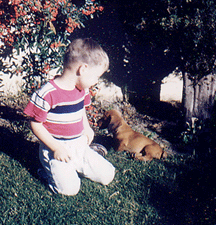I love the English language. My mother had serious disabilities from a dubious back surgery for a couple of years. I was a very active 3 ½ year old little boy. She was stuck with bed-rest and couldn’t even go down the steps into our backyard. (The little Demon with his first dog, Rusty. A contemporary photo) I  would taunt her as she stood on the steps and demanded that I come in the house. What’s a mother to do? Teach the little demon how to read. She would lie in bed and hold the book for me as we went from one word to the other. I loved looking at words and finding their secrets. I am the proud owner of a 1908 unabridged Webster’s, leather bound library dictionary, well worn. I still read it.
would taunt her as she stood on the steps and demanded that I come in the house. What’s a mother to do? Teach the little demon how to read. She would lie in bed and hold the book for me as we went from one word to the other. I loved looking at words and finding their secrets. I am the proud owner of a 1908 unabridged Webster’s, leather bound library dictionary, well worn. I still read it.
Monthly Archives: May 2014
Commands and Signals Revisited:
Ivan Pavlov, the great Russian physiologist, said that in order to survive, animals must have a way to identify beneficial and harmful events before they actually occur. More simply, he said that if a dog had to wait for the claws of a bear to sink into his flesh before he reacted to the threat, there would be no dogs. Likewise, if animals could not learn that thunder in the distance preceded a flash flood or that the snap of a twig preceded a succulent deer, they would be unable to avoid harmful events or take advantage of available entrees. If these examples sound far to simplistic for great science, think again. Sometimes the very best scientific information helps us build secure foundations for more complex knowledge. In the case of Ivan Pavlov, the diligence of his work pays off big-time for anyone interested in the most fundamental of dog training skills.
Abuse or Not Abuse, That is the Question:
About 15 years ago, I spoke at a conference of one of the largest dog training professional organizations. I gave a demonstration of how to safely and quickly stop food aggression. My demonstrator for the event was a five-year-old German Shepherd – not just any German Shepherd. This dog was a FEMA certified search dog. Her problem was that as she grew older, she started attacking any dog that came near while there was food present – which in most cases was another search dog.
Gradual Desensitization and Counter Conditioning: Too little, too late
Author: Gary Wilkes
From a presentation at the Central Veterinary Conference, San Diego 2010
In the world of modern behavior therapy, there are two popular mainstays – gradual desensitization and counter conditioning. If a dog is terrified of thunderstorms, one plays back a sound recording of thunder at very low volume and “desensitizes” the dog to the thunder over a long period of time. Counter Conditioning refers to replacing a currently objectionable behavior with an acceptable behavior. Though widely used and recommended, these tools have very limited ability to control unacceptable companion animal behavior.
Operant Modalities: Alternatives to Psychotropic drugs – Presentation for CVC, Washington DC By Gary Wilkes
One aspect of veterinary behavioral therapy is the use of psychotropic drugs to control behavior. To set the context for my comments, I am not a veterinarian. I do not claim any direct working knowledge of these drugs – but I routinely work with animals that do. Note: This presentation is not about abandoning or curtailing the use of chemical therapy for treating behavior problems. Diagnosis and treatment with psychotropic drugs is often a needed component for a dog’s sustained mental health. The goal of this presentation is to offer a different perspective and potential solutions that dovetail standard medical diagnosis and treatment.
